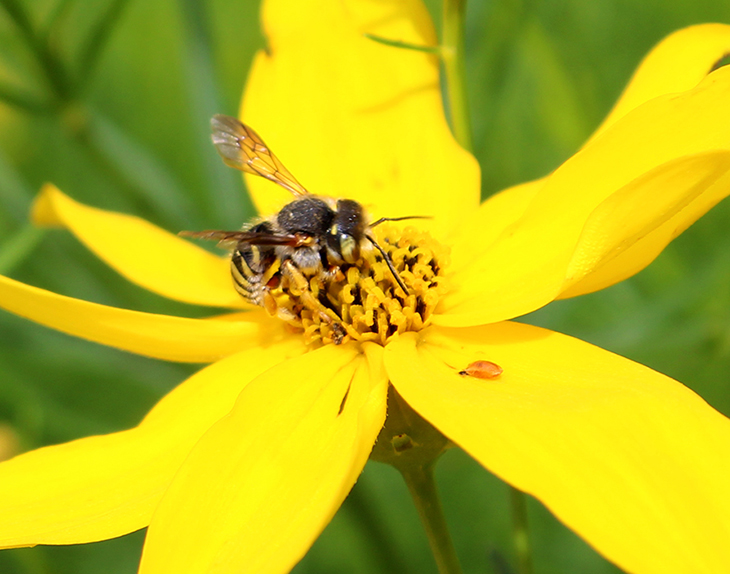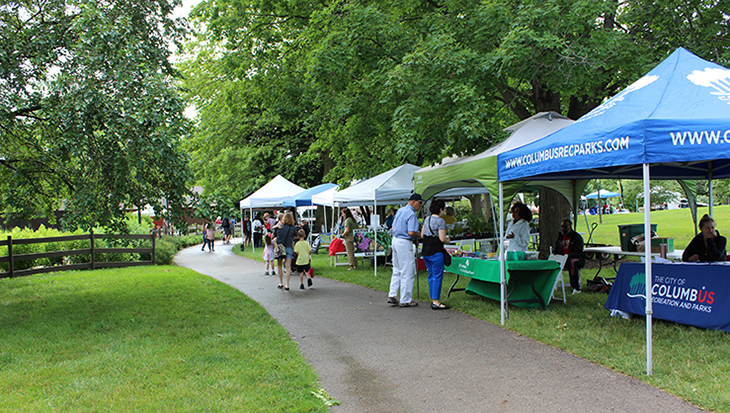
June 24, 2021
Small actions can make a big difference for pollinators, which are critical to life on Earth and increasingly challenged by habitat loss, pesticide use and other threats.
To celebrate and learn about the important environmental role that pollinators play, Ohioans of all ages visited the Franklin Park Conservatory and Botanical Gardens on June 19 for the park’s annual Pollinator Palooza, which kicked off Pollinator Week (June 21-27, 2021). Visitors met with entomologists, observed bees in action and heard from local conservation organizations on how to help pollinators thrive.

“One of the simplest steps you can take to offset global pollinator declines is to create pollinator habitat right where you live with native plants that bloom throughout multiple seasons,” said Marci Lininger, co-founder of the Ohio Pollinator Habitat Initiative (OPHI), which educates Ohioans about the importance of pollinators and spearheads efforts to improve and establish pollinator habitat in the state.
To Lininger, the call to help pollinators came loud and clear while she was working at the U.S. Fish and Wildlife Service in 2014, when the monarch butterfly was first petitioned to be listed under the Endangered Species Act.
“That was a life-changing moment. It just didn’t seem right,” said Lininger, currently executive officer for the Ohio Wildlife Management Association (OWMA) and an environmental coordinator for the Ohio Department of Transportation. “I started thinking, how can we be proactive and not reactive? How can we do something right now, starting today, that says we’re going to change our practices?”
In 2015, Lininger co-founded OPHI with key partners like The Ohio State University, the Ohio Division of Wildlife and USFWS. The organization provides free seed mixes and educational resources, collects milkweed seed pods, participates in outreach events like Pollinator Palooza and helps restore pollinator habitat.
OWMA Secretary Sara Lennert is also advancing pollinator conservation in Ohio through her new business, which helps people design and install pollinator-friendly gardens.
“You can have a pollinator garden in any space. If it’s just one plant, I would still call that a success,” said Lennert, who suggests starting by researching the pollinators local to your area and the plants they require to survive. “It’s commonly known that monarch butterfly caterpillars require milkweed, but many other pollinators have specialized plant relationships as well.”
Specialist bees like hibiscus or squash bees have physical adaptations for collecting nectar and pollen from specific types of flowers, and their life cycle is typically in sync with the bloom periods of these plants, Lennert said.
Lininger and Lennert offered these tips for creating pollinator habitat at home:
- Plant native. Non-native and ornamental species may not have sufficient pollen and nectar for pollinators, and they might not bloom at the right time, said Lennert, cautioning buyers to be wary of products claiming to be for pollinators, as many don’t contain native species. If garden space is limited, Lininger suggests container planting for natives like milkweed, which tend to spread.
- Have blooming plants throughout spring, summer and fall to provide constant and diverse pollinator food sources. Lininger recommends three species of blooming plants in the spring, three to six in the summer and three in the fall.
- Supply a water source, such as a small water tray filled with rocks or marbles for pollinators to land on. Certain plants catch and hold water on their petals and leaves.
“Butterflies like to do what’s called mudding, so if you have some wet muddy areas, that can be useful,” Lennert added.
- Leave bare soil, brush piles or bee nest boxes for overwintering bees and pollinators. Ohio has around 500 native bee species, and most nest underground. Around 30% are cavity nesters, using the hollow stems of plants or pre-existing holes elsewhere. Leaves and brush serve as a more natural mulch and provide cover for other overwintering pollinators.
- Avoid or severely limit pesticide application. “When you use pesticides, there’s no guarantee that pollinators aren’t going to swing by, because we can’t control their behavior,” Lennert said, adding that some pests can be controlled through alternative methods like soapy water, pepper spray or the addition of predatory native insects. If you must use pesticide, pick a dry, sunny day, always follow the instructions, and consider hiring a professional, Lininger said.
“We all rely on pollinators — from the air we breathe to the food we eat,” Lininger said. “We owe it to them to try and help.”